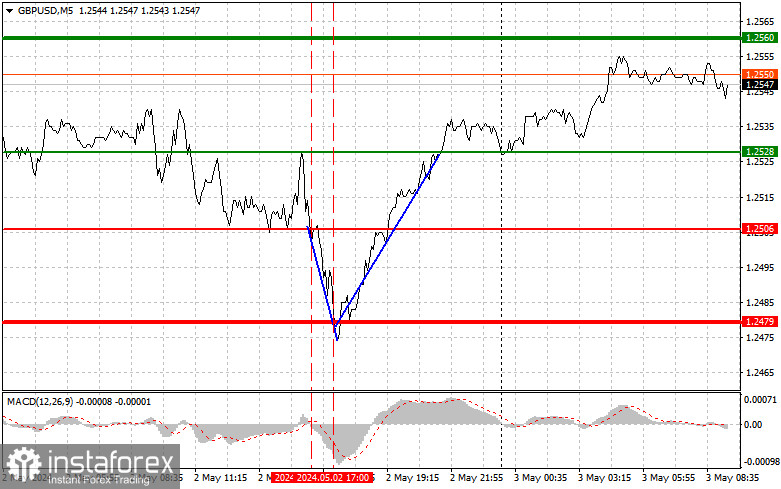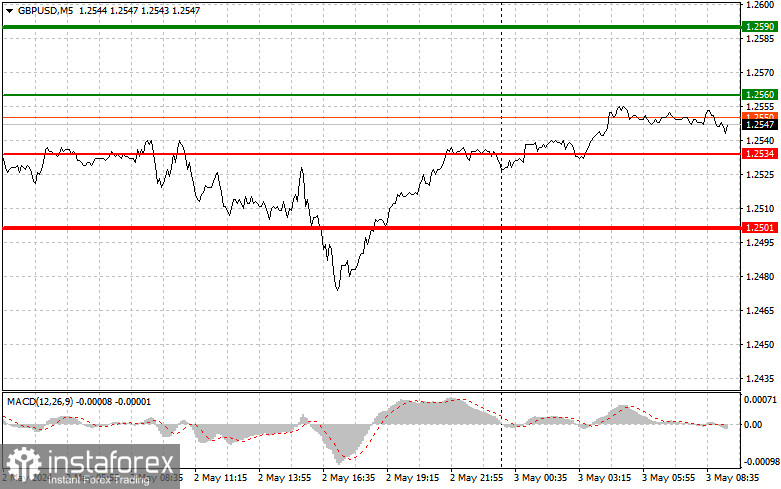Overview of trading and tips on GBP/USD
The price test of 1.2506 in the afternoon occurred at a time when the MACD indicator was just starting to move down from the zero mark, which confirmed the entry point to sell the pound. As a result, the pair fell by more than 25 pips. Buying on the rebound from 1.2479 also brought another 30 pips of profit. Yesterday, the bulls found it difficult due to the lack of UK data and trading near the upper boundary of the channel, but they managed to pull the market from the bottom, so the pair still has the chance to rise further. Today's UK Services PMI and Composite PMI data may sustain the uptrend. However, the figures need to be much higher than economists' forecasts, which is unlikely at the moment, considering the slowdown in the British economy. If the data shows disappointing figures, the pound could fall. As for the intraday strategy, I will rely more on the implementation of scenarios No. 1 and No. 2.

Buy signals
Scenario No. 1. I plan to buy the pound today when GBP/USD reaches the entry point at 1.2560 plotted by the green line on the chart, aiming for growth to 1.2590 plotted by the thicker green line on the chart. In the area of 1.2590, I'm going to close long positions and open short ones in the opposite direction (expecting a movement of 30-35 pips in the opposite direction from the level). You can count on the pound's growth today in continuation of the upward trend and strong UK data. Before buying, make sure that the MACD indicator is above the zero mark and is just starting to rise from it.
Scenario No. 2. I also plan to buy the pound today in case of two consecutive tests of the price of 1.2534 at the time when the MACD indicator is in the oversold area. This will limit the downward potential of the instrument and lead to an upward reversal of the market. We can expect growth to the opposite levels of 1.2560 and 1.2590.
Sell signals
Scenario No. 1. I plan to sell the pound today after testing the level of 1.2534 (the red line on the chart), which will lead to a rapid decline in GBP/USD. The key target for sellers will be 1.2501, where I am going to close short positions and also open long positions in the opposite direction (expecting a movement of 20-25 pips in the upward direction from that level). You can sell the pound after the pair fails to consolidate near the local high and weak data. Before selling, make sure that the MACD indicator is below the zero mark and is just starting to decline from it.
Scenario No. 2: I also plan to sell the pound today in case of two consecutive tests of 1.2560 at the time when the MACD indicator is in the overbought area. This will limit the pair's upward potential and lead to a downward reversal of the market. We can expect a decline to the opposite level of 1.2534 and 1.2501.

What's on the chart:
The thin green line is the entry price at which you can buy the trading instrument.
The thick green line is the price where you can set Take-Profit (TP) or manually fix profits, as further growth above this level is unlikely.
The thin red line is the entry price at which you can sell the trading instrument.
The thick red line is the price where you can set Take-Profit (TP) or manually fix profits, as further decline below this level is unlikely.
MACD line: it is important to be guided by overbought and oversold areas when entering the market
Important: Novice traders in the cryptocurrency market need to be very cautious when making decisions to enter the market. It is best to stay out of the market before important fundamental reports are released to avoid getting caught in sharp price fluctuations. If you decide to trade during news releases, always place stop orders to minimize losses. Without setting stop orders, you can quickly lose your entire deposit, especially if you don't use money management and trade with large volumes.
Remember, for successful trading, it is necessary to have a clear trading plan, similar to the one I presented above. Spontaneously making trading decisions based on the current market situation is inherently a losing strategy for an intraday trader.





















